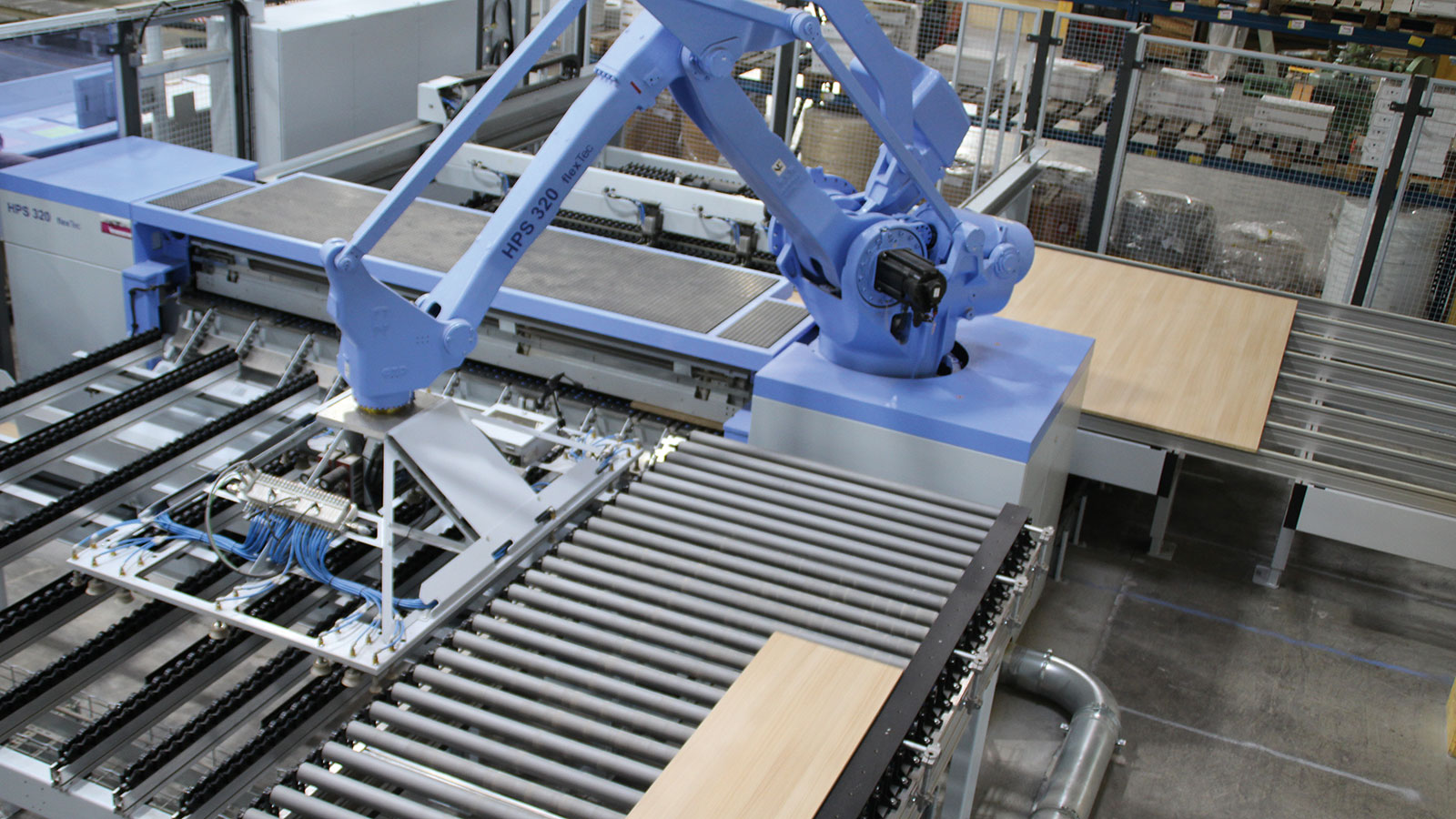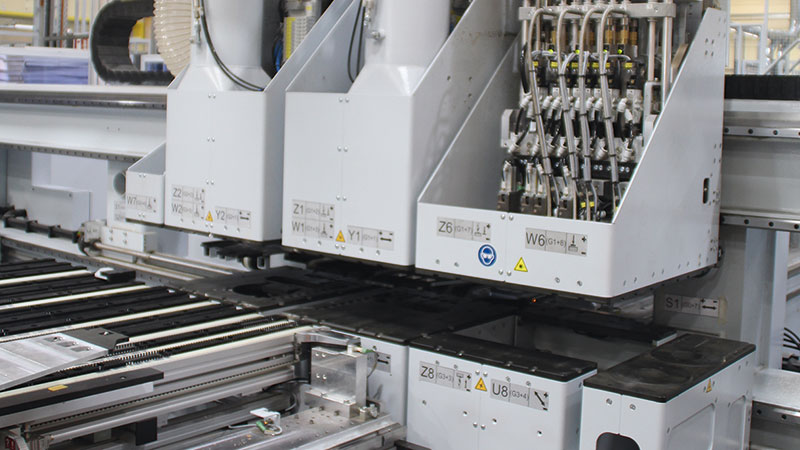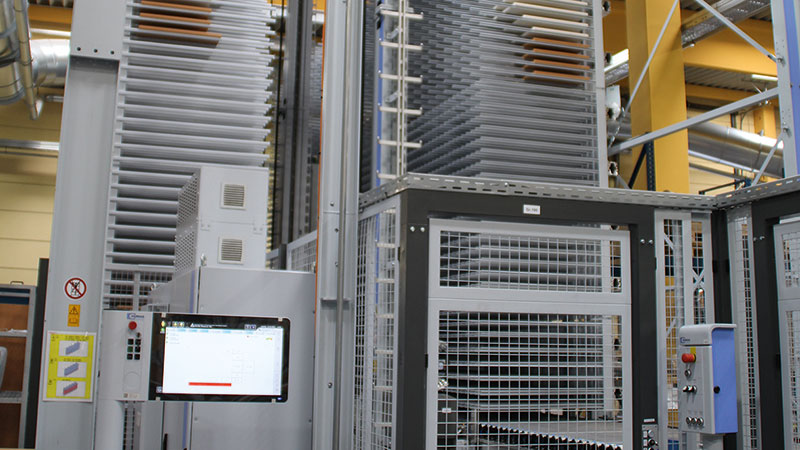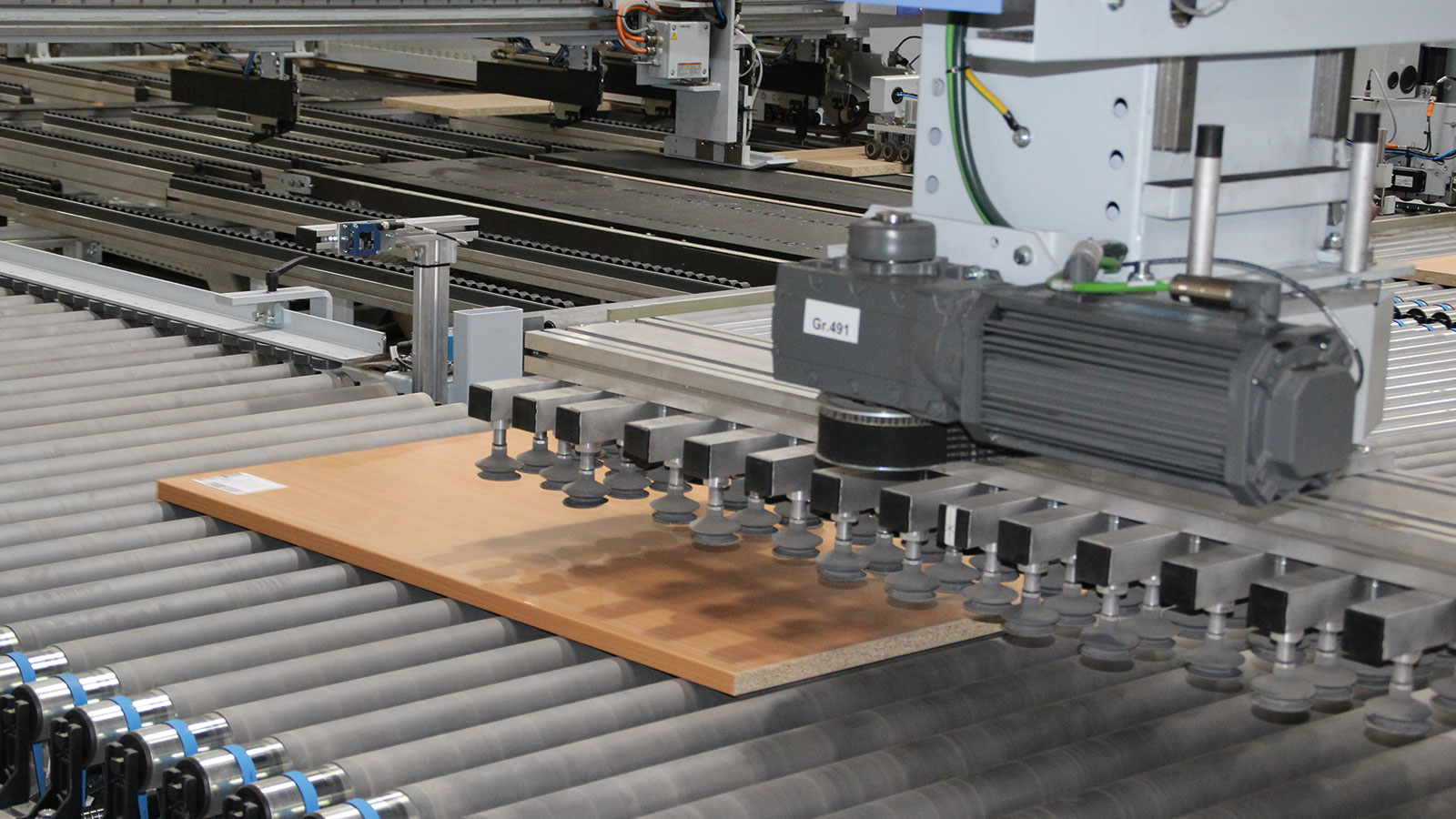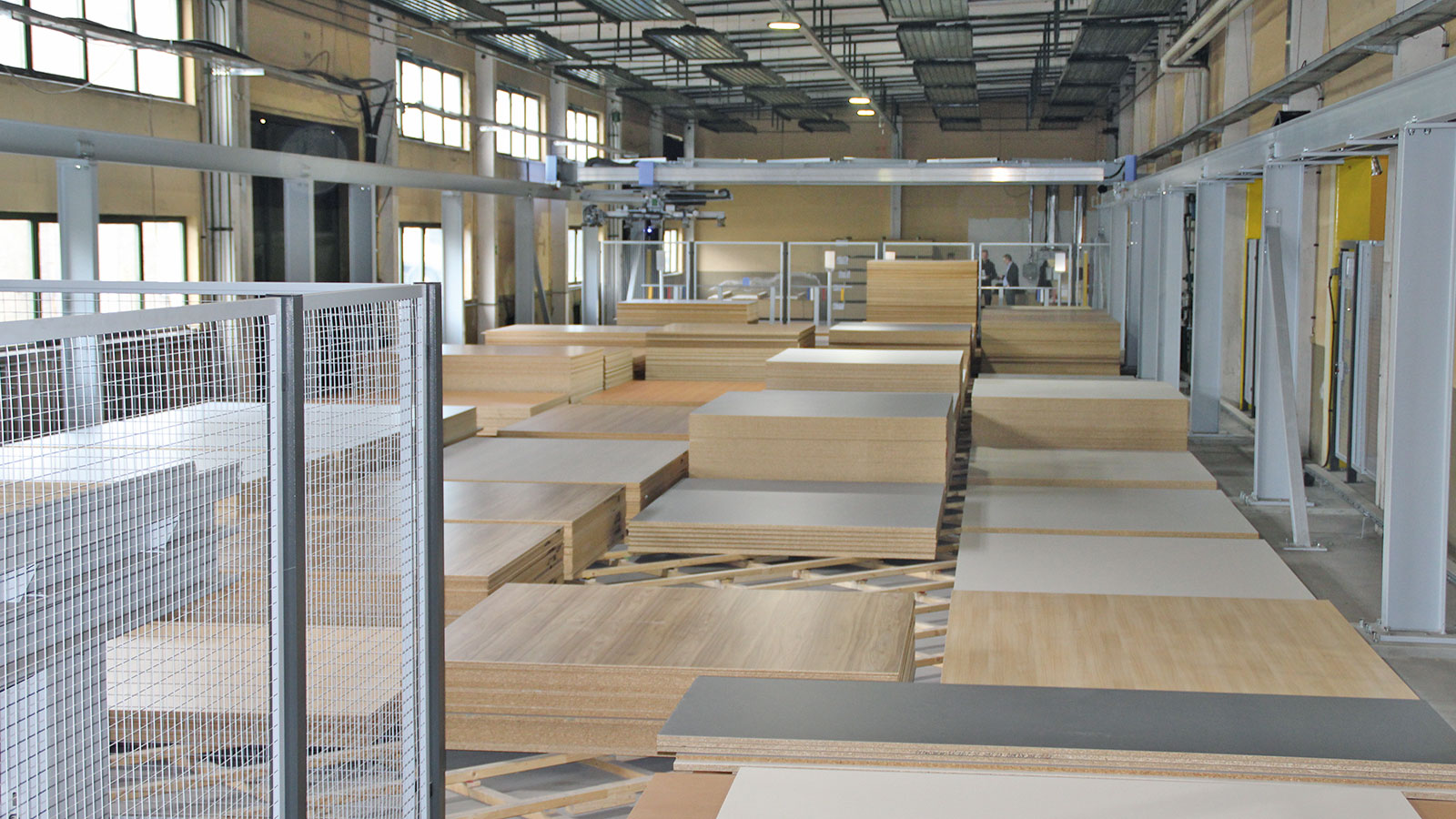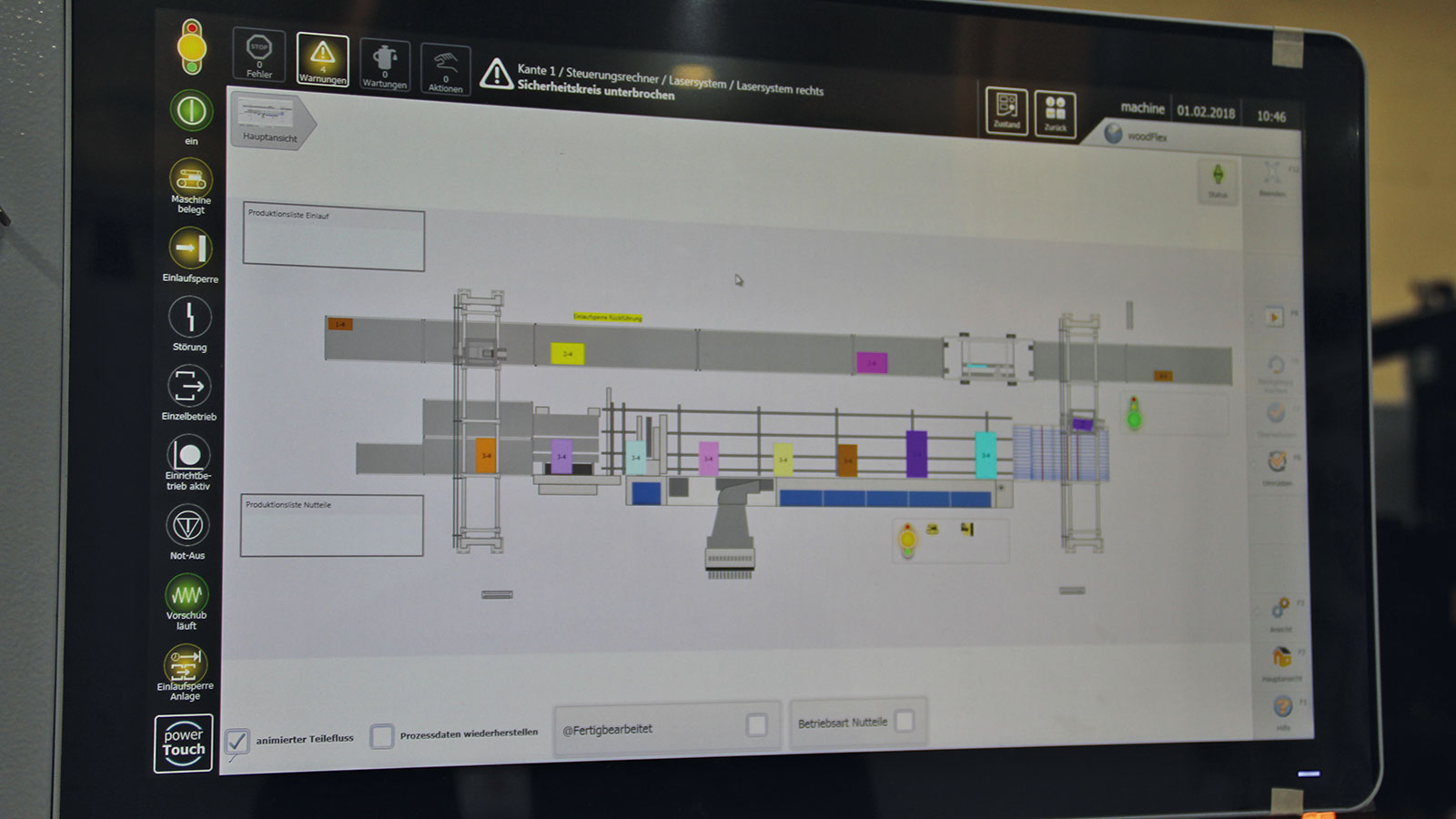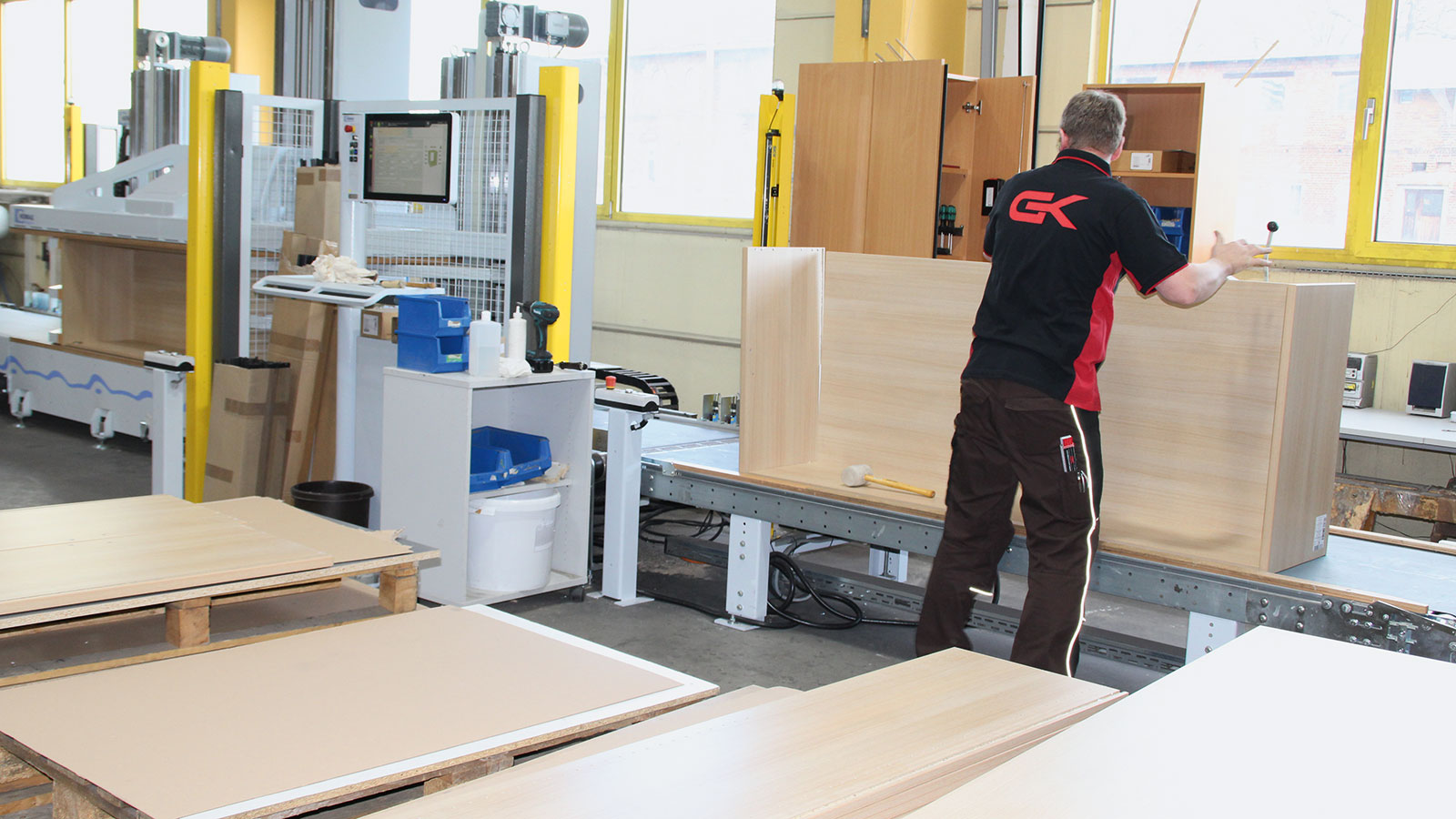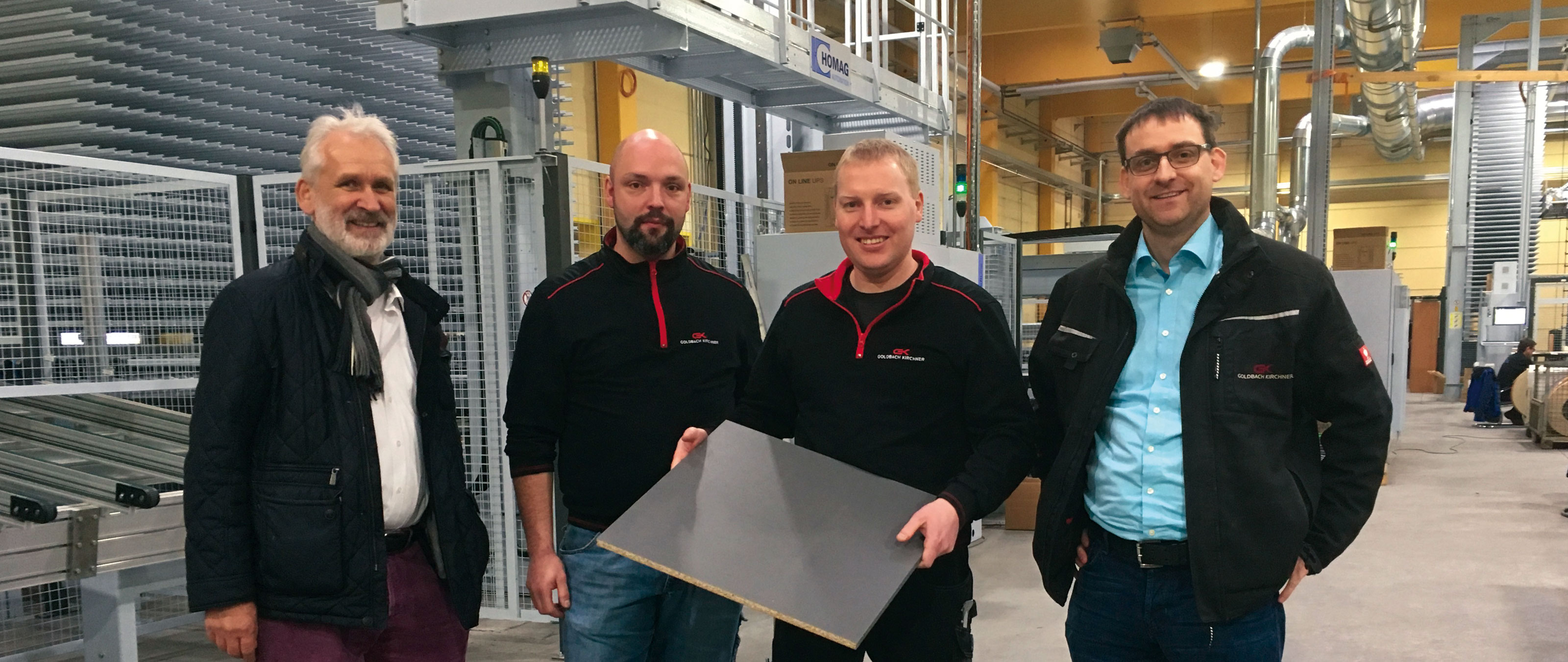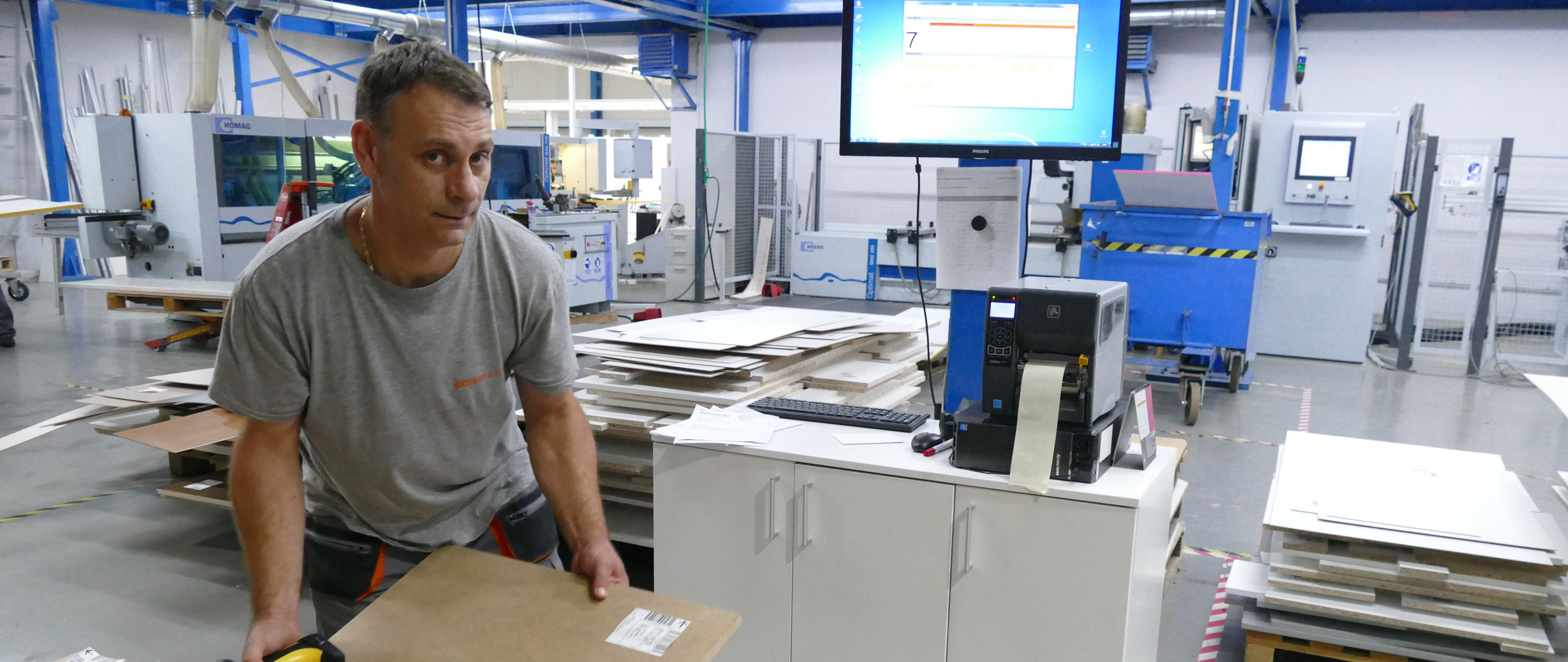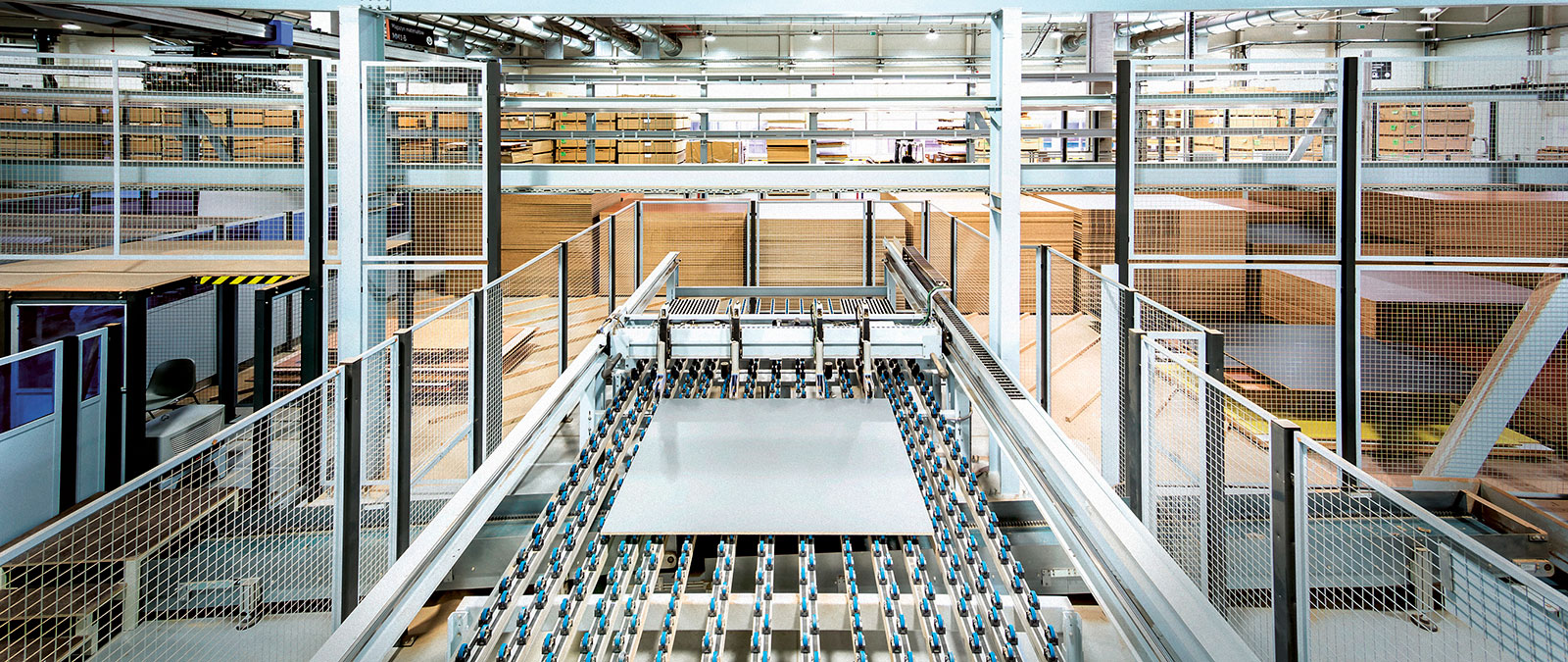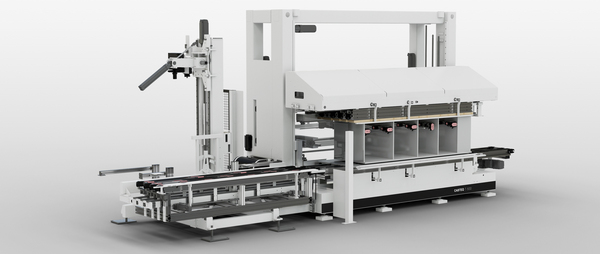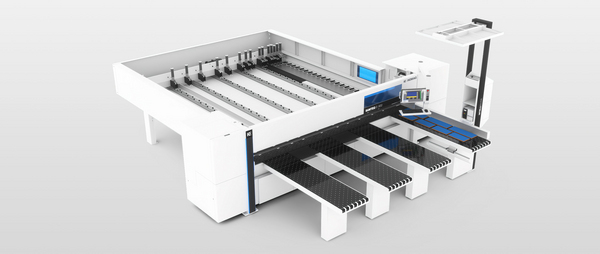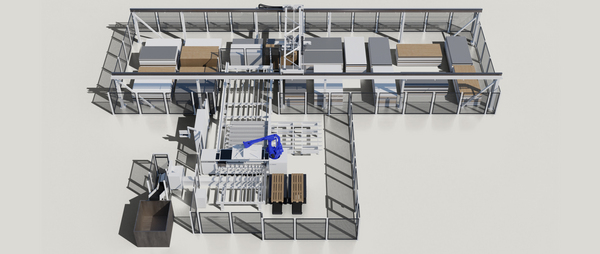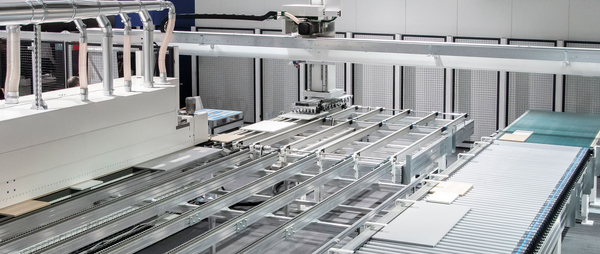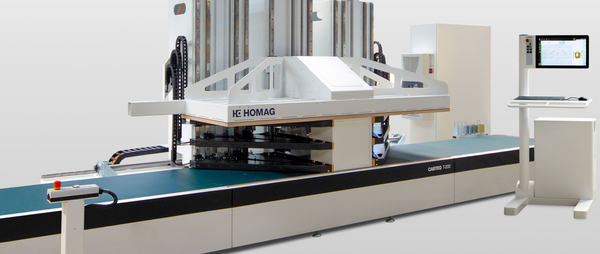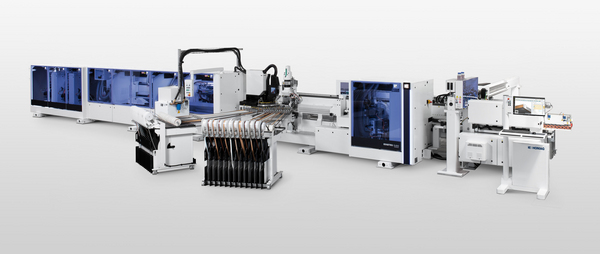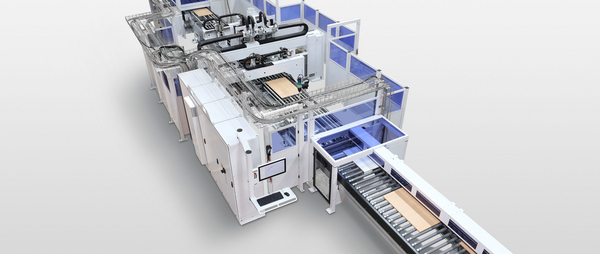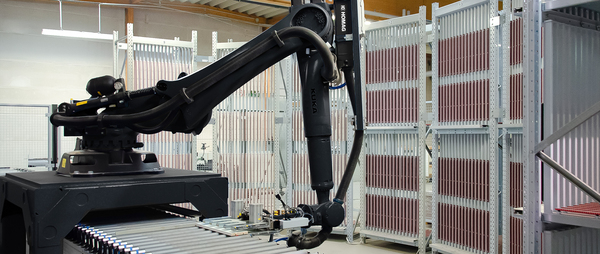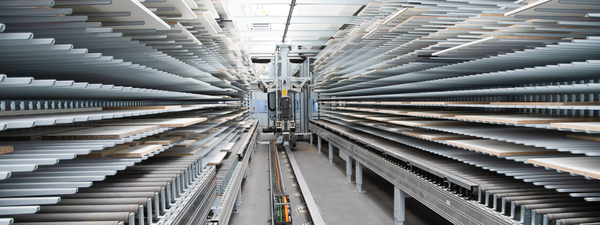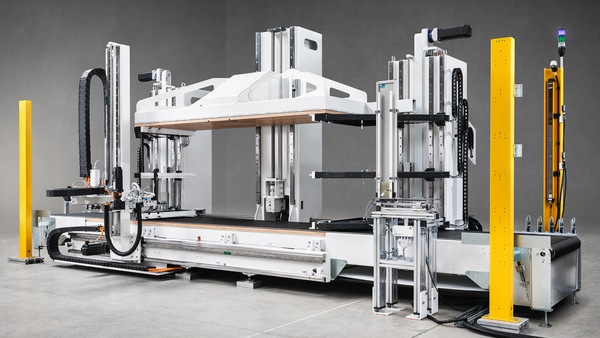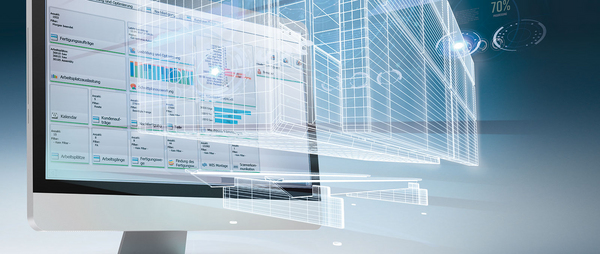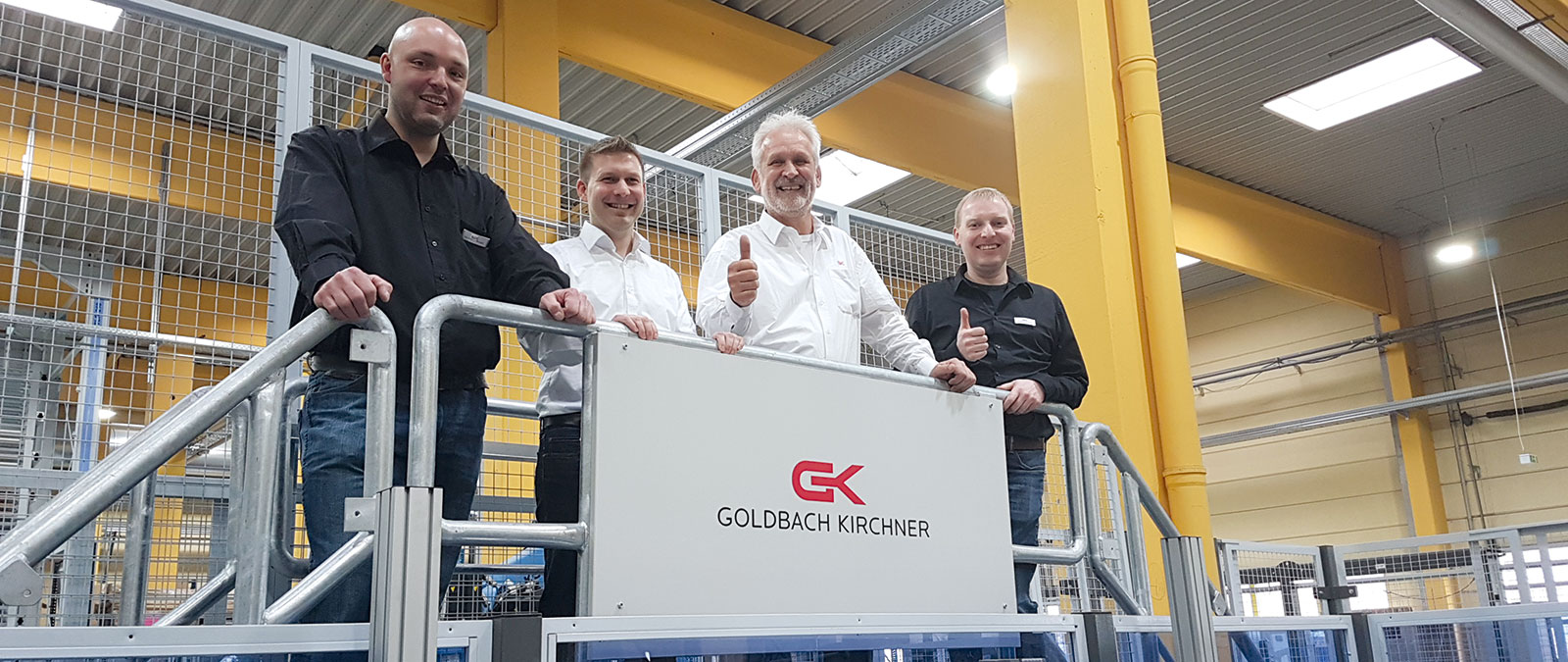
Goldbach Kirchner raumconcepte in Geiselbach, which specializes in interior fittings, has undergone a particular type of capacity expansion. In collaboration with the HOMAG Group, the company created a highly automated production system for cabinet furniture and rectangular components on an old furniture production site in Dessau, in accordance with aspects of Industry 4.0.
Goldbach Kirchner raumconcepte GmbH is an innovative, owner-managed family company which is now run by the third generation of the family. The company from Lower Franconia in Germany specializes in high-quality partition wall and cabinet wall systems, series production and top-class interior fittings. It places great value on in-house, sustainable developments and "made in Germany" production.
A down-to-earth company, its history has repeatedly been shaped by bold corporate decisions. It started with the founder Jakob Kirchner, who, by applying for a patent for the sliding ladder and starting his own production in Geiselbach in 1922, sowed the seeds for a success story.
The current managing director, Bernd Kirchner, is just as enterprising. He gradually expanded the company, turning it into a large carpentry business, and in 2004 took a decisive step by taking over Goldbach raumconcepte GmbH in Goldbach, near Aschaffenburg. Prior to this, the company had focused on producing cabinet wall systems and partition wall systems as well as office furniture for decades. In the same year, Kirchner moved the development and production of the Goldbach products to Geiselbach.
The cooperation between Kirchner Schreinerei Innenausbau GmbH and Goldbach raumconcepte GmbH soon led to synergies in multiple business areas. The final fusion took place in 2006: the two businesses became what is today Goldbach Kirchner raumconcepte GmbH in Geiselbach, with development and production of high-quality cabinet and partition wall systems as well as upmarket interior fittings.
From that point on, all the signs pointed to growth for the strong interior fittings company. This growth manifested itself in 2015 with a further strategically important step: Bernd Kirchner purchased a production site in Dessau, not far from the renowned, historic Bauhaus.
"On a skiing trip, an acquaintance mentioned that the company on the site had gone bankrupt and the entire site was up for sale. Back in the days of the GDR there was a furniture combine on the site, and later it was also a site for woodworking. So there was no harm in the initial idea of using the existing structures. At some point I took the decision to actually go and view the site, but it turned out that it wouldn't be as easy as we thought to produce there. On one hand this was because of the state of the building, and on the other hand, because of the organic, inefficient flow of materials over kilometers of roller conveyors and very outdated machinery," reports the businessman.
Nevertheless, Kirchner saw that the existing buildings had potential. "We didn't have any more options for expansion in Geiselbach, but our market situation meant that we could most definitely grow if we expanded the production volume. That's how we came up with the idea of highly interlinked production in Dessau."
When it became clear that one of the newer buildings in Saxony-Anhalt (which had previously been used as a warehouse) met the required prerequisites, Kirchner decided to make the purchase. Shortly after buying the site in April 2015, including the buildings, planning for the new production line commenced just one month later at LIGNA.
"Because we were able to plan completely from the drawing board, we were able to create a production system that is fit for the future, and that will enable us to satisfy the individual orders from our customers. Thanks to the production in Dessau, we are very strong in series production as well as batch size 1 production and we are realizing our desire to be a truly innovative manufacturer," affirms Kirchner.
The major project was ultimately implemented together with the HOMAG Group. "Goldbach Kirchner has been working with HOMAG since the 1980s. The first machine was a HOLZMA saw. For the plant in Dessau, of course we looked at other manufacturers. But once again, it was the performance of HOMAG, with a really innovative system concept that met all of our requirements for machines and software, that convinced us," says Schmidt, summing up the decision.
The processing of the materials used—chipboard, MDF, lumber-core plywoods, composite elements and melamine-coated panels with and without protective film as well as a maximum unprocessed panel format of 3320 x 2100 millimeters—begins after a STORETEQ S-500 (TLF 411) storage system that is around 50 meters long and 10 meters wide. It has 40 storage slots for 2800 x 2100-millimeter panels, and eight slots for 4100 x 2100-millimeter panels. For materials with a thickness of 19 millimeters, the maximum capacity in the storage system is approximately 5040 panels.
Connected to the storage system—but not integrated in the entire line—is an SAWTEQ B-300 (HPP 300) panel saw with pressure beam labeling. Where necessary, this can be used for individual cuts.
However, the actual material flow bypasses this saw because the storage system gantry operates the infeed of an SAWTEQ B-320 (HPS 320) panel saw with a robot. Here, the unprocessed panels are cut according to the parts data, with the robot taking over the complete handling, including forwarding the panels on after processing, as well as labeling. Depending on the division pattern, this part of the system can create up to 1500 parts per shift.
The SAWTEQ B-320 (HPS 320) is followed by a SORTEQ H-600 (TPL 220) decoupling buffer with 20 tiers and two-channel storage. At the same time, particularly small parts with dimensions of less than 240 x 140 x 10 millimeters can be ejected before the buffer because they cannot be processed in the subsequent machine areas. The procedure is the same for offcuts or finished workpieces, such as rear walls.
"We have taken great care to ensure that in an emergency, we can bypass certain machine areas and can intervene at various points. In a normal situation, the parts run through from the unprocessed panel to the finished part, including edge and bore holes, right up to the end. However, if there is a malfunction on a machine, our special sequence planning prevents the entire line coming to a standstill. Depending on the utilization and the delivery pressure, that can be essential for survival. To be on the safe side, when planning the system we ran through worst case scenarios, such as a power failure," explains Christian Stoll, the operations manager responsible for Dessau.
The buffer position is then followed by a EDGETEQ S-800 (KFR 610) edge banding machine with LOOPTEQ C-500 (TFU 820) parts circulation to provide the workpieces with edges on one or more sides, depending on requirements. PU is used here, or the workpiece and the edge are connected using a laser. ABS, PP, and melamine edges are used, and the machine was equipped with two SF 62 units for groove processing.
Then there is a workpiece transport over two levels with automatic cleaning of both sides of the panels. This part of the system can also buffer in small quantities. From there, the panels go to a SORTEQ R-200 (TLB 320) sorter magazine. With double-depth storage, this part of the system covers around 1500 components and is used to sort the workpieces to which edges have already been applied. For anything that requires no further processing, the magazine is followed by the direct RKR 180 destacking via robot. At this point, parts that require special bore holes can also be fed in.
During destacking, the robot forms tiers automatically in accordance with the individual data records. The robot also rotates the parts for the drilling system. The DRILLTEQ L-500 (ABH 100) throughfeed drilling machine completes the highly automated system. Here, processing takes place on all six sides in one throughfeed without any interfering contours. Dowels are also set in the X direction automatically. There is also a 100 percent measurement and a finished parts buffer for 30 components.
The basis for the entire system is the HOMAG production control system, ControllerMES. This generates the data for the respective parts of the system so that processing can take place in batch size 1. At Goldbach Kirchner, the workpiece information comes from software from Kuhnle as well as CAD+T. ControllerMES then prepares this data for production.
For example, if during design in Geiselbach it is decided that the edge should be applied crosswise first instead of longitudinally for optical reasons, the system then takes this into account and the entire system works such that the part runs in correctly.
In accordance with the data delivered by ControllerMES, the saw processes the corresponding cutting patterns independently and in the same way, the drilling system calls up the required CNC program for the respective component. Quick parts can also be produced at any time. Controller MES responds even if error messages occur due to the automatic quality controls — the system temporarily blocks the entire order.
Start of production for a piece of furniture is four days before the agreed delivery date. Mandatory and optional parts are optimized for cutting in advance. The storage system runs almost constantly. The priority of the panels is determined by predefined priorities, which ControllerMES takes into account when controlling the storage. For example, pre-sorting for the production start for one day takes place automatically the evening before. The storage system orders go to Dessau every two hours, optimized by the work preparation in Geiselbach.
If free-formed workpieces are required for an order, production takes place in Geiselbach. The same applies for complex furniture which would run relatively inefficiently in the new system. "We have regular factory traffic and decide for each order where the parts come together. In some cases that might not be until the construction site," explains Schmidt.
The only other manufacturer besides HOMAG that was involved in setting up the new production facilities was suction specialist Scheuch Ligno: they delivered a "Sepas-Plus" system with a suction performance of 80,000 cubic meters per hour for furniture production, an "Eta-max unit" with high-performance ventilators with 85% efficiency, and a Scheuch Ligno pulse filter with integrated chip bunker. The pneumatic transport system from the pulse filter to the central chip silo covers a distance of around 85 meters, and the transport performance is up to 2800 kg per hour. The operation mode with intervals is especially energy-efficient.
The new HOMAG production system was commissioned in June 2017, with normal operation achieved in October 2017. The average output is 600 to 800 components per shift.
But the company is still working on the maximum efficiency: "Once everything has settled in completely, we will only need one employee for the entire system. At the moment, there are usually three employees on site. And we have a lot of ideas. For example, we're thinking about using an RFID solution instead of barcodes. And at some point, we want to have sophisticated camera systems on-site to monitor the system and to simplify internal maintenance. One thing is clear: this system is state of the art, and in this highly automated form is probably one of the most modern systems in the world. In principle, it is the embodiment of the Industry 4.0 concept. That's why we want to connect even more suppliers. At the moment, only one timber material manufacturer delivers the panels with barcodes that our system can read," explains Schmidt.
There are also plans for the location: "There is a green meadow behind the current production hall we are using. There's enough space to move the administration to a new building and possibly even set up a modern showroom, for example," says Kirchner.
An article from the specialist Magazine möbelfertigung, 03/2018. Images: specialist magazine möbelfertigung. Here you can read the article on www.moebelfertigung.com.
Videos
Please confirm that when you use YouTube, data such as your IP address, browser identifier and similar may be transmitted to Google.
» Privacy Policy
Video: Goldbach Kirchner operates one of the furniture industry’s most up-to-date Industry 4.0 plants.
“The vision was and is that after planning the products in Geiselbach, we send only data records for cabinet furniture and rectangular components to Dessau. The parts are then created there in a highly interlinked automated process with minimal personnel involvement — almost at the press of a button.”Sebastian Schmidt, Production manager Goldbach Kirchner Raumconcepte GmbH

